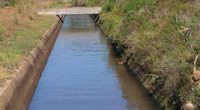 Rehabilitation of Gamtoos Conveyance System
Rehabilitation of Gamtoos Conveyance SystemChallenges
According to Amelius; two great challenges stood out apart from the normal engineering and construction challenges of road, railway and river crossings and high ground water levels among others.
These were determining a risk assessment process and the other was carrying out the rehabilitation works on a ‘live system’, with work time limited to 2 week system shut-downs scheduled during times that demand was historically low.
As part of the Conditional Assessment of the conveyance system, a risk assessment process was followed. The real challenge was to develop methods and norms whereby the condition of a specific element of the conveyance system could be evaluated and “quantified” in order to obtain a level of probability of failure of the specific element.
Together with the potential impact of a partial or complete failure of the element on the water supply, provided the level of risk that could be associated with this particular portion of the conveyance system. This enabled them not only to rank within similar groups of elements, for instance all reinforced concrete pipe siphons, but also to rank amongst various elements, for instance did tunnels pose a similar risk as pre-stressed concrete pipe siphons? This provided the ability to prioritize the work and to provide a rational rehabilitation programme to the DWA.
Visual inspections played an important role to determine the condition of all elements and various criteria were applied to define the level of degradation.,In the case of pre-stressed concrete pipes, Eddy Current Scanning techniques had to be used to determine the inherent remaining strength and integrity of pipes within a siphon and therefore the probability of failure of this element.
Construction Review talked to one of the contractors involved in the project Peter Baxter of WK construction, a building and civil engineering construction company which carried out three of the contracts for the works. Contract No. W 10063 in which they carried out works on the rehabilitation of Line 16 siphon, Contract No. W 0082 involving rehabilitation of Bodker Tunnel/Siphon and Contract No. W 0084 – WTE which involved rehabilitation of De Koning Siphon.
As part of the construction phase, the major challenge was to carry out the rehabilitation work on a “live system”. The only window of opportunity to perform certain critical tasks on the system itself was during the two, two-week dry periods the Gamtoos Irrigation Board (GIB) could offer. It was for instance quite a challenge for WK Construction to re-line a concrete lined pressure tunnel, 2.4m in diameter, with the launch pit seated at the base of an almost inaccessible valley, within this stringent time period. By an innovative approach, the full 140m length was relined by means of a 1.9m diameter steel liner within a period of two weeks.
Going forward all elements of the conveyance system will be closely monitored by the agent to the Department of Water Affairs (DWA), namely the Gamtoos Irrigation Board (GIB) and further remedial work will be initiated at the appropriate time.
Project Team
Consultants
Mbona Saunders and Wium (MSW – Pieter Maritzburg)
Contractors
Southern Pipe Contractors (SPC)
Shearwater Cerimele JV
WK Construction
Active Group Management Services AGMS – George)
Ursa Civils
